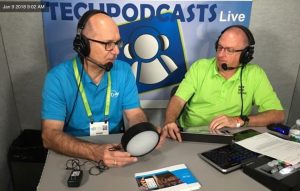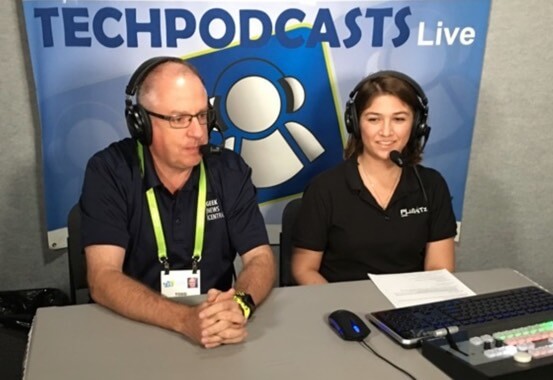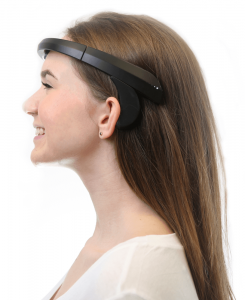CES 2019 Coverage Tech Podcast Network
 CES Live Broadcast Info
CES Live Broadcast InfoAs we have done for many years, those companies wishing to appear on our live CES broadcast need to apply for one of the 80 available slots we have for 2019. Those broadcast slots fill very quickly and by 12-24-2018 we will be 90% booked. So you must act now.
For the second year in a row, we are dedicating 100% of our broadcast hours to highlighting companies that are located in the Sands or Tech West. Companies in the LVCC are welcome to apply but be aware that you have to come to our location.
 The Talent
The TalentThis team will be live and roaming the floor at CES to cover all the latest tech. We look forward to highlighting your products and service.
You must apply, then our team will review your application and inform you if you have been selected for a live appearance in front of or 45,000 live audience members who will be tuned in the 20+ hours we are on the air.

 Fingerprint readers are well established in all but the lowest cost smartphones – look at the Moto G-series for phones priced around US$200 – and it’s a trusted solution. So it’s not surprising that fingerprint readers are now appearing in other devices such as padlocks and bike locks. BIO-key are fingerprint specialists and have a range of locks and readers that do away with keys and passwords. Todd unlocks the potential of his finger with Scott.
Fingerprint readers are well established in all but the lowest cost smartphones – look at the Moto G-series for phones priced around US$200 – and it’s a trusted solution. So it’s not surprising that fingerprint readers are now appearing in other devices such as padlocks and bike locks. BIO-key are fingerprint specialists and have a range of locks and readers that do away with keys and passwords. Todd unlocks the potential of his finger with Scott.
BIO-key’s locks can be opened by a range of technologies depending on the model. Most use fingerprints, but others also have Bluetooth capabilities and some use PIN codes. There are some real benefits in using a fingerprint for unlocking – no key to lose, no combination to remember.
Prices start at US$39.99 for the TouchLock Designer, and a TSA approved lock is $54.95.
BIO-key produce fingerprint readers for PCs too, so if you don’t want to type in your password, check out these USB devices.
Todd Cochrane is the host of the twice-weekly Geek News Central Podcast at GeekNewsCentral.com.
Podcast: Play in new window | Download
Subscribe: Apple Podcasts | RSS | More
 Kano‘s mission is to encourage people, particularly children, to see computers not as unchangeable appliances but as tools to be made, shaped, coded and shared. Their kits plug together bits, boards, buttons and cables to make individual and personalised computers. Bruno gives Todd a hand to develop a selfie camera from their new Camera Kit.
Kano‘s mission is to encourage people, particularly children, to see computers not as unchangeable appliances but as tools to be made, shaped, coded and shared. Their kits plug together bits, boards, buttons and cables to make individual and personalised computers. Bruno gives Todd a hand to develop a selfie camera from their new Camera Kit.
Kano’s approach is to challenge each young developer into programming simple apps that achieve technical goals. Using Kano’s development tools it’s really easy to build programs as the tools come with code building blocks for things like taking a picture or responding to noise via a microphone. Consequently, even Todd can code an app to take a picture when someone claps.
The Camera Kit‘s not expected until next year but you can sign up to hear the latest news. Expect the price to be around US$99.
Todd Cochrane is the host of the twice-weekly Geek News Central Podcast at GeekNewsCentral.com.
Podcast: Play in new window | Download
Subscribe: Apple Podcasts | RSS | More
 Kano‘s mission is to encourage people, particularly children, to see computers not as unchangeable appliances but as tools to be made, shaped, coded and shared. Their kits plug together bits, boards, buttons and cables to make individual and personalised computers. Joanna gets to the heart of the matter with Todd and the Pixel Kit.
Kano‘s mission is to encourage people, particularly children, to see computers not as unchangeable appliances but as tools to be made, shaped, coded and shared. Their kits plug together bits, boards, buttons and cables to make individual and personalised computers. Joanna gets to the heart of the matter with Todd and the Pixel Kit.
Kano’s approach is to challenge each young developer into programming simple apps that achieve technical goals. Using Kano’s development tools, Kano Code, it’s really easy to build programs as the tools come with code building blocks for things like displaying an emoji or responding to noise via a microphone. It’s very easy to quickly produce something that’s fun and keeps children interested.
The Pixel Kit is available now for just under US$80 and GB£75 from both online shops and major retail stores.
Todd Cochrane is the host of the twice-weekly Geek News Central Podcast at GeekNewsCentral.com.
Podcast: Play in new window | Download
Subscribe: Apple Podcasts | RSS | More
 Playing games using bare hands for controllers goes back as far as the Eye Toy for the Sony PlayStation 2 but it was really Microsoft’s Kinect that brought gesture recognition mainstream. Fantastic as these cameras were, players only received visual feedback, e.g. the in-game character moved in the desired direction. But what if there is no TV screen to show feedback? How could the user know that they’ve pressed the right button? That’s where Ultrahaptics come in with their ultrasonic speakers. Todd gets a feeling for the tech with Heather.
Playing games using bare hands for controllers goes back as far as the Eye Toy for the Sony PlayStation 2 but it was really Microsoft’s Kinect that brought gesture recognition mainstream. Fantastic as these cameras were, players only received visual feedback, e.g. the in-game character moved in the desired direction. But what if there is no TV screen to show feedback? How could the user know that they’ve pressed the right button? That’s where Ultrahaptics come in with their ultrasonic speakers. Todd gets a feeling for the tech with Heather.
Simplistically, Ultrahaptics uses ultrasound to project sensations onto a hand. Small highly controllable speakers can focus sound waves to make a hand feel on object that’s not there. It’s pretty clever technology but what it means is that a hand action can receive feedback directly, without needing a screen.
Heather splits the use cases into two, controls and experiences. Want to turn on a light switch? Feel the imaginary switch and flick it up. For experiences, a two-dimensional object could be given three-dimensional properties. Think of a film poster that responds to a hand approach it. The force awakens!
Todd Cochrane is the host of the twice-weekly Geek News Central Podcast at GeekNewsCentral.com.
Podcast: Play in new window | Download
Subscribe: Apple Podcasts | RSS | More
![]() When I hear “hydroponics” I always think of scifi and long missions to deep space. Fortunately, hydroponics is much more rooted in reality than the genre suggests, and this brings us neatly to Opcom Farm and their indoor hydroponics systems. Todd digs with Ray from Opcom and discovers how to garden in your garage.
When I hear “hydroponics” I always think of scifi and long missions to deep space. Fortunately, hydroponics is much more rooted in reality than the genre suggests, and this brings us neatly to Opcom Farm and their indoor hydroponics systems. Todd digs with Ray from Opcom and discovers how to garden in your garage.
Opcom offers everything needed to setup a home hydroponics garden except the space. Even then, the GrowPod can create space within another area, such as a garage, for the racks and shelving needed for a hydroponic garden. These days all the lights are LED, so energy costs are kept low, and there’s a range of units from the simple O2-Light to a full GrowWall. It all depends on the budget – a GrowPod starts at US$2000.
There’s plenty of information on Opcom Farm‘s website and some products are available from Amazon.com. Others are on pre-order for delivery in 2018.
Todd Cochrane is the host of the twice-weekly Geek News Central Podcast at GeekNewsCentral.com.
Podcast: Play in new window | Download
Subscribe: Apple Podcasts | RSS | More
 PicoBrew showed off their personal beer brewing machine and this year, they’re back with a little something to take home alcohol production to the next level. Todd finds out more from George.
PicoBrew showed off their personal beer brewing machine and this year, they’re back with a little something to take home alcohol production to the next level. Todd finds out more from George.
For existing PicoBrewers, the PicoStill brings an opportunity to “up their game” and start distilling small batches of spirits safely and more precisely. 500 ml takes about 4 hours to produce, and up to 180 proof is possible with will multilevel distilling. Alternatively, the PicoStill can capture the essence of hops and other oils to give unique flavors and aromas to food and drinks.
The PicoStill is on pre-order for US$249 ($349 SRP) but it’s an accessory for other brewing appliances (Pico S/Pro/C) so check compatibility before ordering.
Also on show is the Pico C, a smaller and cheaper beer brewing machine for US$549.
Todd Cochrane is the host of the twice-weekly Geek News Central Podcast at GeekNewsCentral.com.
Podcast: Play in new window | Download
Subscribe: Apple Podcasts | RSS | More
![]() True wireless earphones have been around for about eighteen months and products are beginning to innovate away from making the earphones technically better and physically smaller. As an example, Lizn‘s “hearpieces” are wireless earphones but also have some properties of a hearing aid. Todd listens to Michael to find out more.
True wireless earphones have been around for about eighteen months and products are beginning to innovate away from making the earphones technically better and physically smaller. As an example, Lizn‘s “hearpieces” are wireless earphones but also have some properties of a hearing aid. Todd listens to Michael to find out more.
The clue to Lizn’s USP is in the name itself – it’s a play on “listen”. C’mon, keep up. As well as being discreet Bluetooth wireless earphones, the earphones have directional amplification to help the wearer hear conversation in difficult circumstances. The dual microphones use advanced sound processing to enhance the consonants in speech which helps understanding in noisy environments.
The earphones come in three different colours, ruby red, caffe latte and anthracite grey. They’re on pre-order for US$149 with an expected retail price of $199, and should be available in April.
Todd Cochrane is the host of the twice-weekly Geek News Central Podcast at GeekNewsCentral.com.
Podcast: Play in new window | Download
Subscribe: Apple Podcasts | RSS | More
 Being “in the zone” reflects that total mental focus and clarity that comes to people concentrating hard. For athletes and professionals, it can take years of practice and hard work. For us mere mortals, BrainCo offers a way to learn how to focus. How? Professor Don gets all brainy with Max.
Being “in the zone” reflects that total mental focus and clarity that comes to people concentrating hard. For athletes and professionals, it can take years of practice and hard work. For us mere mortals, BrainCo offers a way to learn how to focus. How? Professor Don gets all brainy with Max.
 The idea behind BrainCo is to use their Focus One headband with gamification to improve mental concentration. The BrainCo band reads small electrical impulses in the wearer’s brain and picks up on changes in the frequency and amplitude of the impulses (EEG). As everyone’s brains are different the band establishes a personal baseline and works on changes from that baseline to understand when the person is relaxed, focussed or distracted.
The idea behind BrainCo is to use their Focus One headband with gamification to improve mental concentration. The BrainCo band reads small electrical impulses in the wearer’s brain and picks up on changes in the frequency and amplitude of the impulses (EEG). As everyone’s brains are different the band establishes a personal baseline and works on changes from that baseline to understand when the person is relaxed, focussed or distracted.
While wearing the Focus One headband, the owner plays a smartphone game which takes information from the headband and responds as the wearer mentally focusses. Simply, the person has to focus to do well in the game. Overtime, the person learns how to focus their mind.
The BrainCo Focus One reinforces good mental behaviour and this can be especially useful for children who have learning difficulties such as ADHD, but it also has application in ensuring that teachers are engaging with their students.
The FocusOne isn’t yet available to buy but if you are interested, you can register on the BrianCo website for an early bird discount.
Don Baine is the Gadget Professor and gives lectures at TheGadgetProfessor.com.
Podcast: Play in new window | Download
Subscribe: Apple Podcasts | RSS | More